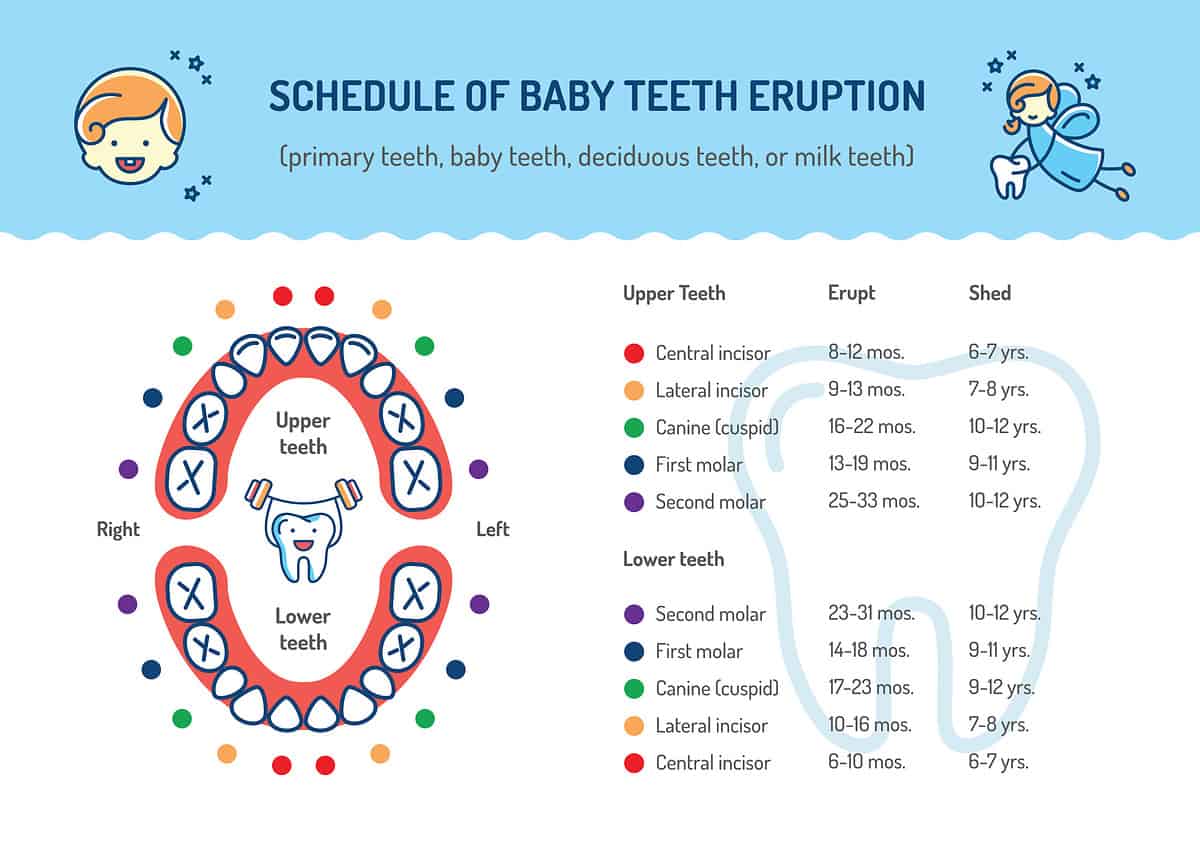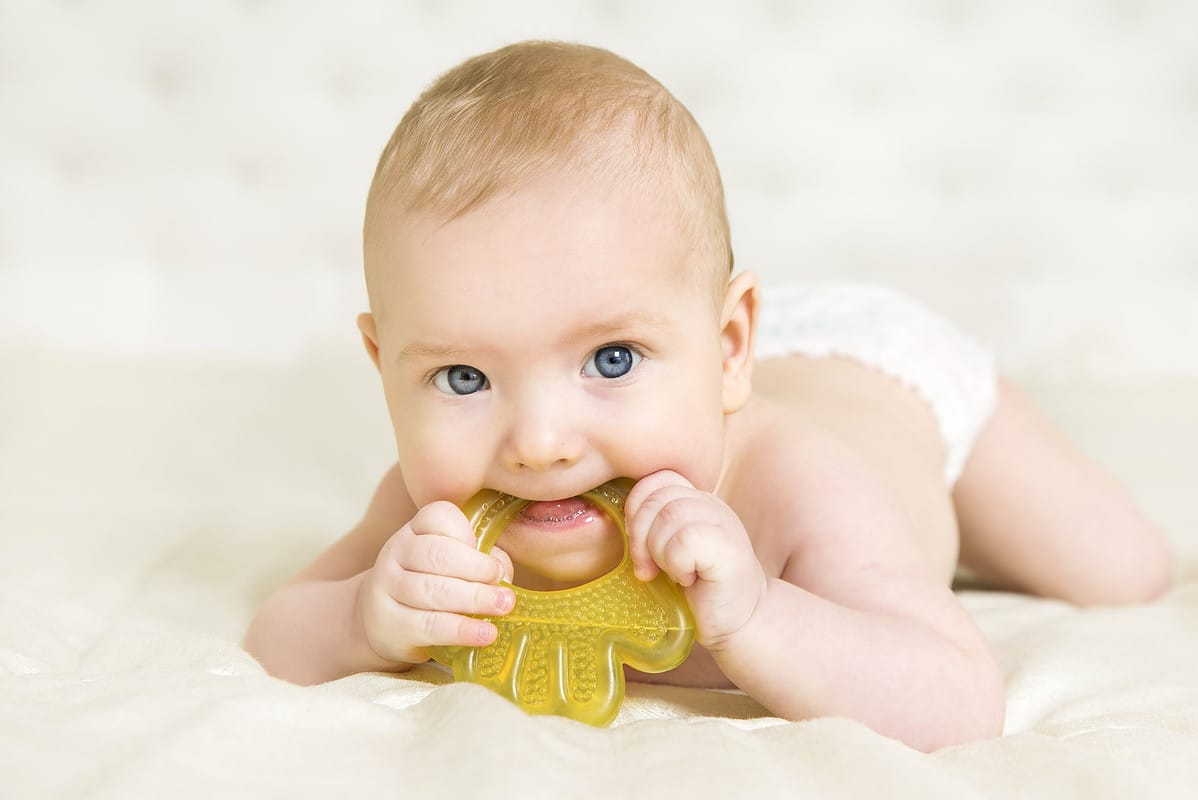Although teething is an entirely normal part of development for babies and toddlers, it is often a dreaded part of your baby getting older. This is because teething can cause discomfort and pain in our little ones. Therefore, knowing how to soothe a teething baby is a great tool to have as a parenting skill.
Babies are born with their first complete set of teeth burrowed underneath their gums. Throughout the first year of life, these teeth will begin to emerge. While it's a natural process, it can be distressing for some babies. The pain is compacted by babies' inability to express their feelings or what is hurting them. Therefore, it leaves parents and doctors having to evaluate the puzzle pieces and figure out how to soothe their babies when they aren't feeling their best.
When Do Babies Teeth?
When your baby begins teething, it will vary. No baby is on the same timeline. Therefore, while the average time for babies to begin teething is around six months old, this can vary by a few months before or after.
The first set of teeth to typically come in first are the bottom central incisors, followed by the top. From there, your baby will continue to cut teeth until they have their first complete set. Take a look at the teething chart below to gain a better understanding of when all your baby's teeth may emerge.

©Decobrush/Shutterstock.com
Symptoms of Teething
It can be normal for babies to have no symptoms if they are teething. However, babies may sometimes exhibit one or more of the following symptoms.
- Drooling
- Irritability
- Excessive chewing
- Fussiness and unexplained crying
- Tender or sore gums
- Swollen gums
- Red gums
- Loss of appetite
- Staying awake at night
While these symptoms can be typical for a teething baby, following up with your pediatrician is always a good idea. This is especially important if your baby develops symptoms not typical of teething. These symptoms can include:
- A rash
- Cough
- Vomiting
- Diarrhea
How to Soothe a Teething Baby in 9 Steps
It can feel challenging as a parent to soothe a teething baby. However, these nine steps are tried-and-true ways to offer comfort to your little one, especially when it feels like there's not much you can do. If you know your baby is teething and want to comfort them any way you can, you can try these nine steps!
1. Cuddle Your Baby
Teething can be painful for babies. To top it off, they have no idea why they are feeling the pain; if they are especially young, they will not understand even if you explain it to them! Cuddles from someone they love and feel safe with can be one of the best things you can do for your teething baby.
Understanding, patience, cuddling, and love are great for a teething baby.

©FamVeld/Shutterstock.com
2. Massage Your Baby's Gums
Your baby's gums are most likely sore and red. Wash your hands thoroughly and apply firm and gentle pressure on your baby's swollen gums. Doing so will increase blood flow. Plus, it will feel good on your baby's gums!
Try using your finger or even a gum rubbing pad. The pressure your baby feels will be comforting; they may even enjoy chewing on your clean finger for a little bit! Doing this at least twice a day can be immensely helpful. Try once in the morning and once before bed.
3. Next, Use a Damp Wash Cloth on Baby's Gums
Another option is to rub or apply gentle pressure on your baby's gums with a damp washcloth. The pressure helps alleviate the discomfort that your baby is feeling. There are specific wash clothes that are geared towards babies. These wash clothes are softer than the typical kitchen ones and feel better on your baby's gums.
4. Give Baby a Teething Ring
A teething ring is popular for soothing a baby's sore gums. There are a few things to remember about teething rings, though. Do not place them in the freezer because this can lead to accidental breaking and choking incidents. Additionally, the sharp ice may harm the baby's gums. Instead, place the teething ring in the refrigerator. Your baby will still reap the benefits of having something cold to chew on without the choking risk.
If you do not have a teething ring on hand, you can chill a metal spoon in the refrigerator, or if your child is older and can chew, offering cold fruit can alleviate pain and discomfort.

©inarik/ via Getty Images
5. Give Baby a Bath
Have you ever heard the old saying, if they are crabby, put them in water? While this doesn't always work, there is something relaxing about taking a warm bath! Try giving your baby a soothing, warm bath to help them relax and wind down. Doing so may be comforting to your baby.
6. If Baby Can Chew, Give a Teething Cracker
Sometimes, the best remedy for teething is chewing. You may see your baby try to chew on numerous things, including toys and clothes, or even bite others. If this is happening, give your baby a teething cracker if they have reached the stage where they can chew. Teething crackers will typically melt in the mouth, allowing babies to soothe teething pain.
7. Offer a Cold Sippy Cup of Water if Baby is Older than 6-9 Months
Additionally, if your child is older than six to nine months, giving them a cold, sippy cup of water can also help with teething discomfort. The cool spout will soothe their pain, and the pressure can ease swelling.
8. Try Pain Medicine
Sometimes, the best thing you can do is offer pain medicine to your baby. While it's essential always to consult your doctor first, infant acetaminophen is generally considered safe to give babies.
9. Give Baby Tons of Patience and Love
Babies who are going through teething can be very fussy and cranky. They do not understand the pain and have no idea how to make it stop. Continue to help your baby by trying these methods. Additionally, offering them plenty of love and patience will make the transition of cutting teeth a whole lot easier for them. They will feel safe and comforted when the person they depend on is patient and loving.
While it can be very tiring for parents who are trying to help babies with their teething pain, it is important to remember that this is only a phase. Eventually, your baby will return to their usual happy self with more teeth! Also, asking for support and help makes it easier for parents to remain patient.

©Trendsetter Images/Shutterstock.com
Remedies to Avoid
While there are many great ways to soothe a baby who is going through cutting teeth, there are a few things that you should avoid doing.
- Do not place teethers in the freezer; this can be a choking hazard or cause pain in the gums.
- Avoid using topical gels that contain benzocaine or lidocaine. While rare, benzocaine can lead to methemoglobinemia, which is life-threatening. Lidocaine can cause seizures and heart issues.
- Also, do not give babies teething necklaces or bracelets; while well intended, they pose a choking hazard.
Call your doctor if your baby's teething pain or fussiness doesn't improve with time.
One Last Note
Teething is an entirely normal process that every baby goes through. Ultimately, they will emerge with a complete set of teeth that will aid them in nourishing their bodies. However, the process can be painful for the baby and draining for the parents. With these simple, soothing techniques, you can offer comfort to your baby, reduce swelling or pain, and reinforce that they are safe and loved with you.
The image featured at the top of this post is ©Oksana Kuzmina/Shutterstock.com.
